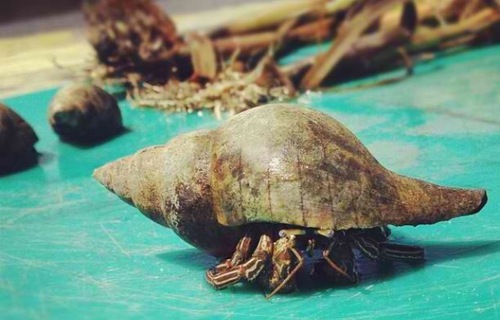Thinstripe Hermit
Clibanarius vittatusSummary 8
Clibanarius vittatus, the thinstripe hermit crab, is a species of hermit crab in the family Diogenidae. It is found the Caribbean Sea, the Gulf of Mexico and the western Atlantic Ocean.
Description 9
The thinstripe hermit crab, Clibanarius vittatus, is an easily recognizable species present in abundance throughout the IRL. The claw-bearing legs, called chelipeds, are equal in size and covered with short spines and hairs (Voss 1980). The claws themselves are also equal in size, cylindrical, and fairly small (Ruppert & Fox 1988). Fingers open horizontally to reveal several teeth, and the exterior of the claws are covered in bluish tubercles (Williams 1984). Body coloration is greenish to dark brown and marked with conspicuous gray or white stripes, which are most noticeable on the legs. C. vittatus inhabits a variety of gastropod shells, commonly from whelk and conch species (see 'Associated Species' below).
Distribution 10
The range of C. vittatus extends from the Virginia coast in the eastern U.S. south to Brazil (Williams 1984). Crabs can be found on sheltered beaches, mud and sand flats, on rock jetties, in seagrass beds and among mangrove roots, in oyster beds and other coastal habitats to a depth of 22 m (e.g. Williams 1984). Because it can withstand desiccation better than many other hermit crabs, C. vittatus is usually the species found on exposed tidal flats and beaches at low tide (Ruppert & Fox 1988).Indian River Lagoon (India River Lagoon) Distribution:The thinstripe hermit is possibly the most common hermit species in the India River Lagoon, and is located throughout the lagoon in most submerged or intertidal habitats.
Size 11
With the exception of the giant hermit crab, Petrochirus diogenes, C. vittatus is likely the largest hermit crab species in the IRL. The anterior shield of the carapace ranges from about 14 to 17 mm in length (Williams 1984). Adult crabs are commonly found inhabiting gastropod shells at least 10 cm long (Ruppert & Fox 1988).
Look alikes 12
Although several species of hermit crabs are found in the IRL and surrounding Florida waters, the coloration and pattern of stripes on C. vittatus make it readily distinguishable from other species.
Link to Access Genomic Data 13
http://www.ncbi.nlm.nih.gov/Taxonomy/Browser/wwwtax.cgi?id=6751&lvl=0
Sources and Credits
- (c) Bernadette, some rights reserved (CC BY-NC), uploaded by Bernadette
- (c) matbio, all rights reserved
- (c) Andrea Westmoreland from DeLand, United States, some rights reserved (CC BY-SA), https://upload.wikimedia.org/wikipedia/commons/2/20/Clibanarius_vittatus_%283812736938%29.jpg
- (c) morgansmith1, some rights reserved (CC BY-NC)
- (c) 2010 Moorea Biocode, some rights reserved (CC BY-NC-SA), http://calphotos.berkeley.edu/cgi/img_query?seq_num=91384&one=T
- (c) 2010 Moorea Biocode, some rights reserved (CC BY-NC-SA), http://calphotos.berkeley.edu/cgi/img_query?seq_num=91414&one=T
- (c) Crabby Taxonomist, some rights reserved (CC BY-NC-SA), https://www.flickr.com/photos/crabby_taxonomist/7212897828/
- Adapted by matbio from a work by (c) Wikipedia, some rights reserved (CC BY-SA), http://en.wikipedia.org/wiki/Clibanarius_vittatus
- Adapted by matbio from a work by (c) Smithsonian Marine Station at Fort Pierce, some rights reserved (CC BY-NC-SA), http://eol.org/data_objects/11525908
- Adapted by matbio from a work by (c) Smithsonian Marine Station at Fort Pierce, some rights reserved (CC BY-NC-SA), http://eol.org/data_objects/11525909
- Adapted by matbio from a work by (c) Smithsonian Marine Station at Fort Pierce, some rights reserved (CC BY-NC-SA), http://eol.org/data_objects/11525913
- Adapted by matbio from a work by (c) Smithsonian Marine Station at Fort Pierce, some rights reserved (CC BY-NC-SA), http://eol.org/data_objects/11525911
- (c) Emily Rose Sharkey, all rights reserved











